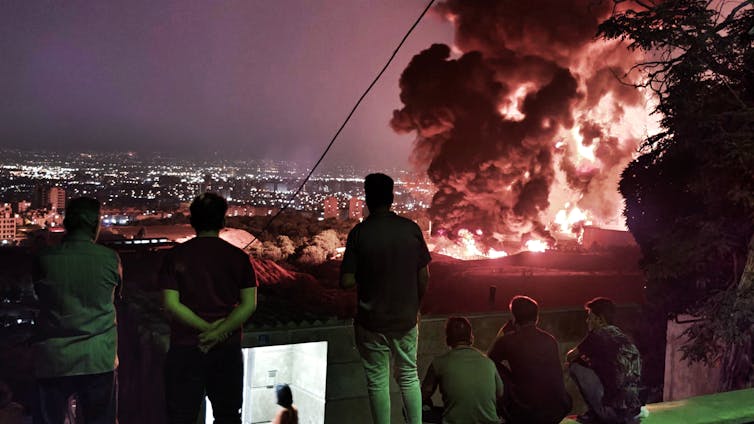 Onlookers witness the aftermath of an Israeli airstrike targeting an oil depot in Tehran, Iran, on June 15, 2025. Stringer/Getty Images
Onlookers witness the aftermath of an Israeli airstrike targeting an oil depot in Tehran, Iran, on June 15, 2025. Stringer/Getty ImagesThe recent U.S. bombings of three critical nuclear sites in Iran have plunged the already strained relations between the two nations to unprecedented lows. This animosity is far from a new development; the historical conflict traces back several decades, notably beginning in August 1953 when the U.S. orchestrated the overthrow of the democratically elected prime minister, Mohammed Mossadegh. Following this coup, the U.S. supported the oppressive regime of the Shah of Iran, whose brutal security forces inflicted suffering upon the Iranian populace for many years. This foundational event laid the groundwork for ongoing tensions and mutual distrust.
The hostility intensified dramatically in November 1979 when Iranian students seized control of the U.S. Embassy in Tehran, leading to severe economic sanctions and the complete severance of formal diplomatic ties between the two countries. This incident marked a pivotal shift in U.S.-Iran relations, contributing to decades of political strife and mutual antagonism.
Since 1984, the U.S. State Department has categorized Iran as a “state sponsor of terrorism,” alleging that the Iranian government extends support, including training, financial aid, and weaponry, to terrorist organizations. This classification has had far-reaching implications on the geopolitical landscape in the Middle East, further complicating any potential for diplomatic relations and fostering an environment of fear and mistrust.
Examining key historical events in U.S.-Iran relations reveals not only stark differences in the nations’ perspectives but also instances that could have paved the way for reconciliation. Recognizing these moments is essential for understanding the complexities that define their interactions over the decades.
1953: The U.S. Orchestrates the Overthrow of Prime Minister Mossadegh
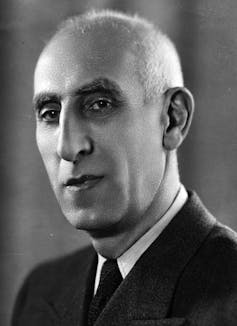 Prime Minister Mohammed Mossadegh. Wikimedia Commons
Prime Minister Mohammed Mossadegh. Wikimedia CommonsIn 1951, the Iranian Parliament appointed a new prime minister, Mossadegh, who advocated for nationalizing the Anglo-Iranian Oil Company, effectively expelling British interests and redirecting oil profits towards the benefit of the Iranian populace. The U.S. government, fearing disruptions in global oil supply and the potential for Soviet influence in Iran, aligned with the British government, who were concerned about losing access to inexpensive Iranian oil.
President Dwight Eisenhower determined that removing Mossadegh was crucial for U.S. and U.K. interests. The covert operation, known as Operation Ajax, orchestrated by the CIA in collaboration with British intelligence, resulted in the Shah of Iran dismissing Mossadegh and forcibly removing him from power. The aftermath saw the installation of a prime minister favored by Western powers, further entrenching foreign influence in Iran’s political landscape.
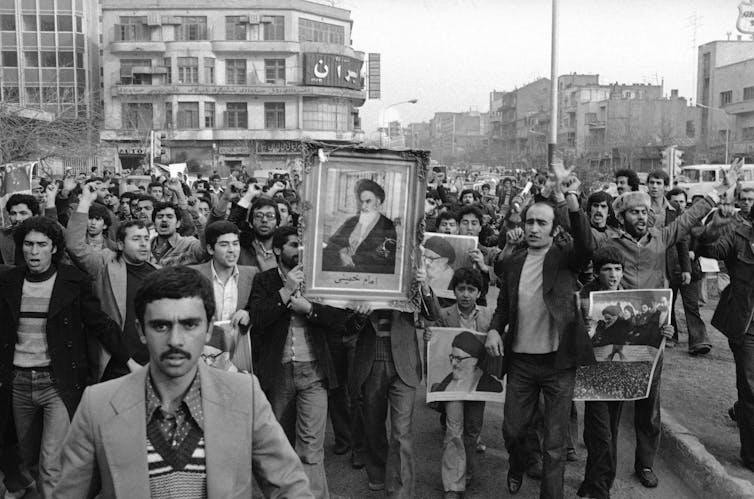 Protesters in Tehran demand the establishment of an Islamic republic. AP Photo/Saris
Protesters in Tehran demand the establishment of an Islamic republic. AP Photo/Saris1979: Revolutionaries Oust the Shah and Take American Hostages
Following more than 25 years of relative stability in U.S.-Iran relations, dissatisfaction among the Iranian populace grew due to the social and economic disparities fostered by the authoritarian regime of Shah Mohammad Reza Pahlavi. The Shah’s regime, characterized by widespread corruption and reliance on American financial assistance to bolster his military, resulted in significant poverty among ordinary Iranians. Dissent was systematically suppressed by SAVAK, the Shah’s brutal secret police.
In January 1979, the Shah left Iran ostensibly for medical treatment, and shortly thereafter, Ayatollah Ruhollah Khomeini returned from exile, galvanizing the public to abolish the monarchy and establish an Islamic government. The public fervor for change was palpable, leading to a revolution that drastically altered the country’s political landscape.
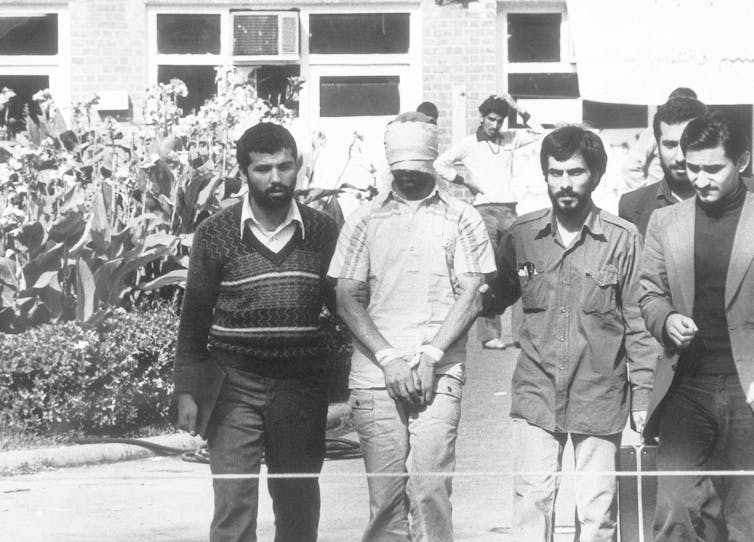 Iranian students at the U.S. Embassy in Tehran display a blindfolded American hostage for the crowd in November 1979. AP Photo
Iranian students at the U.S. Embassy in Tehran display a blindfolded American hostage for the crowd in November 1979. AP PhotoIn October 1979, President Jimmy Carter allowed the Shah to seek treatment in the U.S., prompting outrage among Iranian students who stormed the U.S. Embassy in Tehran on November 4, taking 52 Americans hostage. This dramatic act of defiance led to the severance of diplomatic relations between the U.S. and Iran on April 7, 1980. The hostage crisis lasted a staggering 444 days, culminating in the release of the hostages on January 20, 1981.
In a desperate attempt to rescue the hostages, the U.S. military launched a failed mission that resulted in the tragic loss of eight servicemen, further complicating U.S.-Iran relations and deepening animosity.
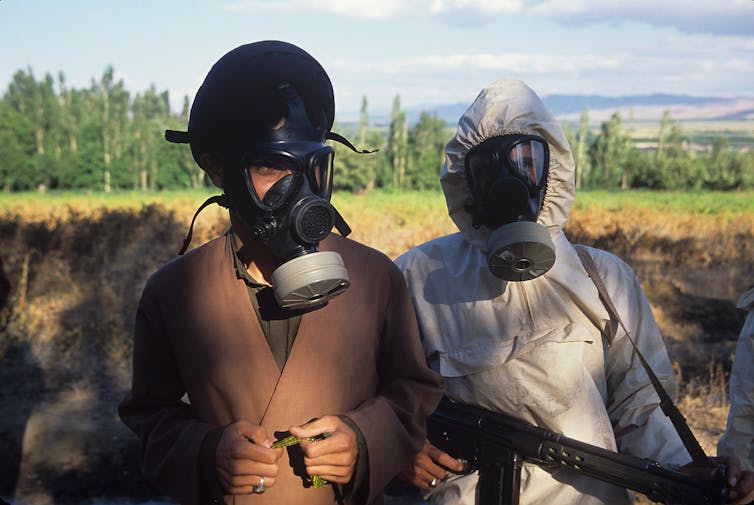 An Iranian cleric and soldier don gas masks to protect themselves against chemical weapons attacks from Iraq in May 1988. Kaveh Kazemi/Getty Images
An Iranian cleric and soldier don gas masks to protect themselves against chemical weapons attacks from Iraq in May 1988. Kaveh Kazemi/Getty Images1980-1988: The U.S. Tacitly Supports Iraq During the Iran-Iraq War
In September 1980, Iraq launched an invasion of Iran, escalating a regional rivalry fueled by religious and political differences. Iraq, under Sunni leadership, faced a predominantly Shia population, while Iran was governed by a Shia regime. The U.S. grew increasingly concerned that the conflict could disrupt oil supplies from the Middle East, particularly affecting its close ally, Saudi Arabia.
Consequently, the U.S. provided tacit support to Iraqi leader Saddam Hussein in his fight against Iran, often overlooking Iraq’s use of chemical weapons against Iranian forces. This controversial decision stemmed from a desire to prevent Iran from gaining regional dominance and was met with significant criticism for compromising human rights and ethical standards in warfare.
Despite the U.S. government’s usual opposition to chemical warfare, officials refrained from condemning Iraq’s actions, fearing that public outcry could benefit Iran’s propaganda efforts. The war ultimately ended in 1988 with no clear victor, resulting in devastating losses, including over 500,000 military personnel and 100,000 civilian casualties.
1981-1986: The U.S. Secretly Sells Weapons to Iran Despite an Arms Embargo
After Iran was designated a state sponsor of terrorism in 1984, the U.S. imposed a strict arms embargo that left the Iranian military in dire need of weapons and parts while it was engaged in a protracted war with Iraq. Recognizing the risks of pushing Iran towards Soviet support, the Reagan administration opted for a clandestine approach, allowing the covert sale of weapons to Iran beginning in 1981.
The last of these secret shipments, which included anti-tank missiles, occurred in October 1986, but the operation was exposed by a Lebanese magazine, igniting the Iran-Contra scandal. This scandal revealed that Reagan officials had diverted profits from the arms sales to support anti-socialist rebels, known as the Contras, in Nicaragua, leading to widespread political fallout and controversy.
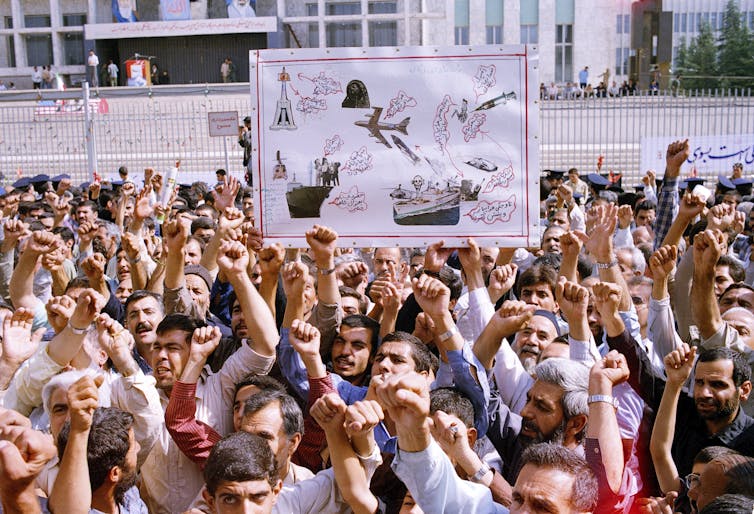 Mourners at a mass funeral for victims of the downing of Iran Air 655 hold up a sign depicting the incident. AP Photo/CP/Mohammad Sayyad
Mourners at a mass funeral for victims of the downing of Iran Air 655 hold up a sign depicting the incident. AP Photo/CP/Mohammad Sayyad1988: The U.S. Navy Accidentally Shoots Down Iran Air Flight 655
On July 8, 1988, the USS Vincennes, a guided missile cruiser operating in international waters of the Persian Gulf, engaged in a skirmish with Iranian gunboats and inadvertently entered Iranian territorial waters. During the confrontation, the crew mistook a civilian Airbus passenger jet for an enemy fighter aircraft, leading to a catastrophic decision to shoot it down, resulting in the tragic loss of all 290 individuals onboard.
The U.S. government labeled the incident a “tragic and regrettable accident,” while Iranian officials perceived it as a deliberate act of aggression, further fueling animosity between the two nations. In 1996, the U.S. agreed to pay $131.8 million in compensation to the families of the victims, but the incident left a lasting scar on U.S.-Iran relations.
1997-1998: The U.S. Attempts to Reestablish Contact with Iran
In August 1997, Mohammad Khatami, a moderate reformer, was elected as Iran’s president, prompting the U.S. to explore the possibility of renewed diplomatic engagement. President Bill Clinton recognized this opportunity and sent a message through the Swiss ambassador proposing direct government-to-government talks.
In January 1998, Khatami expressed admiration for the American people in an interview and suggested fostering cultural exchanges between the two nations. However, the Iranian supreme leader, Ayatollah Ali Khamenei, opposed such overtures, resulting in limited progress towards improved relations. Tensions escalated again with President George W. Bush labeling Iran, along with Iraq and North Korea, as part of an “Axis of Evil,” further straining bilateral ties.
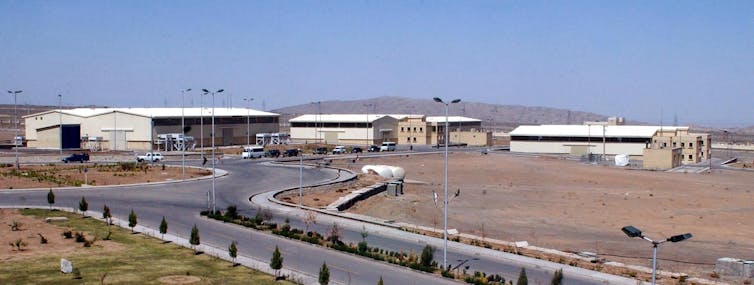 Technicians enrich uranium at the Natanz nuclear facility in Iran. AP Photo/Vahid Salemi
Technicians enrich uranium at the Natanz nuclear facility in Iran. AP Photo/Vahid Salemi2002: Alarming Revelations About Iran’s Secret Nuclear Program
In August 2002, an exiled opposition group disclosed that Iran had been secretly developing nuclear weapons capabilities at two undisclosed sites, violating its commitments under the Nuclear Nonproliferation Treaty. This treaty mandates that signatory nations disclose all nuclear-related facilities to international inspectors. The revelation of the Natanz facility, which housed centrifuges for uranium enrichment, raised international concerns over Iran’s intentions, given that enriched uranium can fuel both civilian reactors and nuclear weapons.
Beginning in 2005, U.S. and Israeli cyber operatives launched a coordinated effort, utilizing a sophisticated malware program known as Stuxnet to disrupt the operations of Iran’s centrifuges. This cyberattack was part of a broader international strategy aimed at curtailing Iran’s progress towards acquiring a nuclear arsenal, an objective that has proven challenging despite numerous attempts.
2003: Iran Reaches Out to the Bush Administration for Dialogue
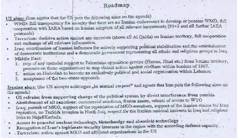 An excerpt from a document sent from Iran through the Swiss government to the U.S. State Department in 2003, indicating a desire for dialogue. Washington Post via Scribd
An excerpt from a document sent from Iran through the Swiss government to the U.S. State Department in 2003, indicating a desire for dialogue. Washington Post via ScribdIn May 2003, high-ranking Iranian officials discreetly contacted the U.S. State Department, proposing a dialogue grounded in mutual respect that addressed critical issues, including nuclear proliferation, terrorism, Palestinian resistance, and stability in Iraq. However, hardline factions within the Bush administration were resistant to diplomatic overtures, despite Secretary of State Colin Powell‘s inclination towards dialogue.
With the election of hardliner Mahmoud Ahmadinejad in 2005, the window for negotiation effectively closed. The following year, Ahmadinejad sent an 18-page letter to President Bush, which was largely dismissed by U.S. officials, reflecting the widening chasm in U.S.-Iran relations.
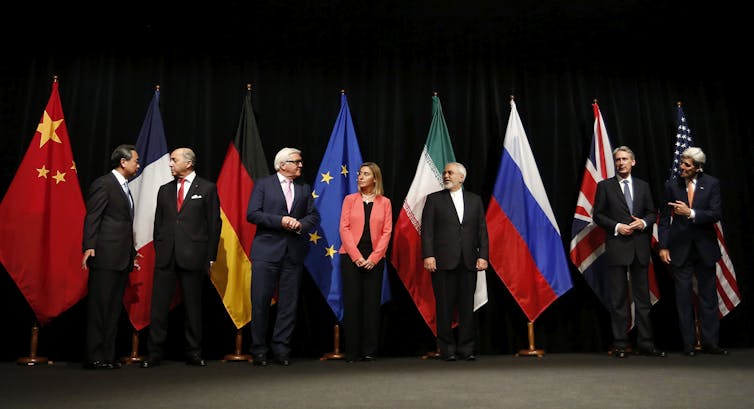 Representatives from multiple nations convene in Vienna in July 2015 to negotiate the Iran nuclear deal. Austrian Federal Ministry for Europe, Integration and Foreign Affairs/Flickr
Representatives from multiple nations convene in Vienna in July 2015 to negotiate the Iran nuclear deal. Austrian Federal Ministry for Europe, Integration and Foreign Affairs/Flickr2015: The Historic Signing of the Iran Nuclear Deal
After years of failed attempts to contain Iran’s nuclear ambitions, the Obama administration adopted a direct diplomatic approach starting in 2013. This initiative led to two years of secret negotiations, initially between the U.S. and Iran and later involving other nuclear powers, culminating in the Joint Comprehensive Plan of Action, commonly known as the Iran nuclear deal.
Signed in 2015 by Iran, the U.S., China, France, Germany, Russia, and the United Kingdom, the agreement imposed strict limitations on Iran’s uranium enrichment capacities and mandated comprehensive international inspections to ensure compliance. In exchange for adhering to the terms, Iran received relief from extensive international and U.S. economic sanctions.
While international inspectors consistently verified Iran’s compliance with the agreement, President Donald Trump officially withdrew from the accord in May 2018, reigniting tensions and uncertainty in the region.
2020: The U.S. Drone Strike that Killed Iranian Maj. Gen. Qassem Soleimani
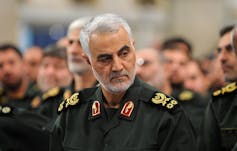 An official image from the Iranian government depicting Maj. Gen. Qassem Soleimani, who was killed in a drone strike ordered by President Donald Trump on January 3, 2020. Iranian Supreme Leader Press Office/Anadolu Agency via Getty Images
An official image from the Iranian government depicting Maj. Gen. Qassem Soleimani, who was killed in a drone strike ordered by President Donald Trump on January 3, 2020. Iranian Supreme Leader Press Office/Anadolu Agency via Getty ImagesOn January 3, 2020, an American drone strike resulted in the death of Maj. Gen. Qassem Soleimani, the head of Iran’s elite Quds Force. Analysts regarded Soleimani as one of the most influential figures in Iran, second only to Supreme Leader Ayatollah Khamenei. The Trump administration claimed that Soleimani was orchestrating an imminent attack on U.S. assets, but no definitive evidence was provided to substantiate this assertion.
In retaliation, Iran launched a series of ballistic missile strikes targeting two American military bases in Iraq, escalating tensions and raising concerns about a potential conflict.
2023: The October 7 Attacks on Israel and Their Impact on Regional Dynamics
The audacious assault by Hamas on Israel on October 7, 2023, provoked a fierce military response from Israel, which continues to unfold and has severely weakened Iran’s proxies in the region, particularly Hamas—the group responsible for the attacks—and Hezbollah in Lebanon. This development indicates a shifting balance of power and raises questions about the future of Iranian influence in the Middle East.
2025: Trump’s Second Term and Renewed Negotiations with Iran
With the inauguration of his second term, Donald Trump recognized an opening to negotiate a new nuclear deal with Iran and explore various business opportunities. He appointed Steve Witkoff, a real estate investor and personal friend, as special envoy for the Middle East, tasking him with leading negotiations.
Negotiations between Washington and Tehran commenced in April, yet no agreement was reached. Just as both parties were preparing for another round of discussions, Israel launched a series of airstrikes on Iran on June 13, prompting the White House to reassess its position.
On June 22, the U.S. executed a decisive military strike, targeting three Iranian nuclear sites and inflicting what Pentagon officials described as “severe damage.” In response, Iran vowed to retaliate, further complicating an already tense situation.
This article has been updated to reflect the U.S. bombing of Iranian nuclear sites on June 22, 2025.
Jeffrey Fields, Professor of the Practice of International Relations, USC Dornsife College of Letters, Arts and Sciences
This article is republished from The Conversation under a Creative Commons license. Read the original article.
![]()
SEE ALSO:
Appeals Court Allows Trump To Keep Control Of National Guard In LA
The Disrespect: Trump Disregards Juneteenth, Says US Has ‘Too Many Non-Working Holidays’

Here you can find the original article; the photos and images used in our article also come from this source. We are not their authors; they have been used solely for informational purposes with proper attribution to their original source.






